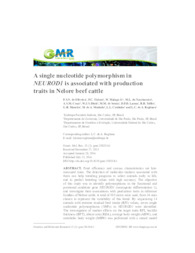A single nucleotide polymorphism in NEUROD1 is associated with production traits in nelore beef cattle.
A single nucleotide polymorphism in NEUROD1 is associated with production traits in nelore beef cattle.
Autoria: OLIVEIRA, P. P. A.; TIZIOTO, P. C.; MALAGO JUNIOR, W.; NASCIMENTO, M. L. do; CESAR, A. S. M.; DINIZ, W. J. da S.; SOUZA, M. M. de; LANNA, D. P. D.; TULLIO, R. R.; MOURAO, G. B.; MUDADU, M. de A.; COUTINHO, L. L.; REGITANO, L. C. de A.
Resumo: Feed efficiency and carcass characteristics are late-measured traits. The detection of molecular markers associated with them can help breeding programs to select animals early in life, and to predict breeding values with high accuracy. The objective of this study was to identify polymorphisms in the functional and positional candidate gene NEUROD1 (neurogenic differentiation 1), and investigate their associations with production traits in reference families of Nelore cattle. A total of 585 steers were used, from 34 sires chosen to represent the variability of this breed. By sequencing 14 animals with extreme residual feed intake (RFI) values, seven single nucleotide polymorphisms (SNPs) in NEUROD1 were identified. The investigation of marker effects on the target traits RFI, backfat thickness (BFT), ribeye area (REA), average body weight (ABW), and metabolic body weight (MBW) was performed with a mixed model using the restricted maximum likelihood method. SNP1062, which changes cytosine for guanine, had no significant association with RFI or REA. However, we found an additive effect on ABW (P ≤ 0.05) and MBW (P ≤ 0.05), with an estimated allele substitution effect of -1.59 and -0.93 kg0.75, respectively. A dominant effect of this SNP for BFT was also found (P ≤ 0.010). Our results are the first that identify NEUROD1 as a candidate that affects BFT, ABW, and MBW. Once confirmed, the inclusion of this SNP in dense panels may improve the accuracy of genomic selection for these traits in Nelore beef cattle as this SNP is not currently represented on SNP chips.
Ano de publicação: 2016
Tipo de publicação: Artigo de periódico
Unidade: Embrapa Pecuária Sudeste
Palavras-chave: Bos Indicus, Candidate gene, Feed efficiency, Gado Nelore, Gado de corte, Nelore
Observações
1 - Por padrão são exibidas publicações dos últimos 20 anos. Para encontrar publicações mais antigas, configure o filtro ano de publicação, colocando o ano a partir do qual você deseja encontrar publicações. O filtro está na coluna da esquerda na busca acima.
2 - Para ler algumas publicações da Embrapa (apenas as que estão em formato ePub), é necessário ter, no celular ou computador, um desses softwares gratuitos. Sistemas Android: Google Play Livros; IOS: iBooks; Windows e Linux: software Calibre.
Acesse outras publicações
Acesse a Base de Dados da Pesquisa Agropecuária (BDPA) para consultar o acervo completo das bibliotecas da Embrapa.

